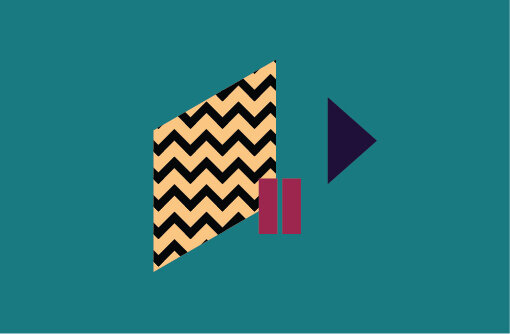Media on media
Media diversity and racism in the media are hot topics frequently discussed in media. Media on Media is a curated selection of media content - podcasts, opinion pieces, regular programs and more - about issues ranging from diversity debates and decolonial practices to media justice and the politics of representation - and prioritising sovereign and self-determined expert voices.
A PDF version of media on media resources (Dec 2021) is available here.
Podcasts, community radio broadcasts and panel discussions
A look back at Australia's first national radio program produced and presented by Indigenous broadcasters changed the game in Black media.
In this Point Special, John Paul Janke speaks with Catherine Liddle, CEO of First Nations Media Australia and Muriel Bamblett, CEO of the Victorian Aboriginal Child Care Agency about how government agencies and institutions can be held to account to ‘Close the Gap’ and make meaningful and lasting reforms for First Nations people. The Point, Season 2020 Episode 4, NITV.
A panel discussion curated by IndigenousX exploring how state sanctioned violence is enabled and protected by racist ideology, and the role of protests in achieving reform.
NITV Channel Manager & Media Diversity Australia Board member Tanya Orman talks about racism and representation in the NITV newsroom, Kodie Bedford's Twitter thread, an open letter from SBS employees to appoint a BIPOC to News Director, and an open letter to the Melbourne Press Club to recognise the need for greater diversity on its board. Take it Blak podcast (episode 10), NITV online. Co-hosted by Jack Latimore and Rhanna Collins.
Black Stories Matter is a five-part podcast series that brings together media researchers, historians, former policy makers and Aboriginal journalists whose work is disrupting the patterns of the past. The series was inspired by the book Does the Media Fail Aboriginal Political Aspirations: 45 years of news media reporting of key political moments by Amy Thomas, Heidi Norman and Andrew Jakubowicz from the Faculty of Arts and Social Sciences at UTS.
This event brought together First Nations women working in community, media and journalism for a discussion about the tensions between their work and the white feminism that often characterises Australian media narratives as part of the Broadly Speaking series.
A panel discussion that challenges the defence of the status quo and identifies how institutional barriers—from Australian schools and universities all the way to newsroom—work to directly and indirectly exclude Aboriginal and/or Torres Strait Islander, non-Indigenous Black and POC journalists and presenters. Hosted by Anya Saravanan, and featuring Areej Nur, Osman Faruqi, Madeline Hayman-Reber and Jim Malo. Jointly presented by 3CR Community Radio's Tuesday Breakfast Team and Democracy in Colour.
Boe Spearim travelled to Alice Springs for the 2019 Converge conference host by First Nations Media Australia. Boe speaks with James Saunders from IndigenousX, Lola Forester from Koori Radio and Damien Williams from CAAMA Radio. Let’s Talk, 98.9fm, November 2019.
Boe Spearim travelled to Alice Springs for the 2019 Converge conference host by First Nations Media Australia. Boe speaks with James Saunders from IndigenousX, Lola Forester from Koori Radio and Damien Williams from CAAMA Radio. Let’s Talk, 98.9fm, November 2019.
This morning on Let’s Talk, Dan Rennie shines a light on some of the exceptional work of our First Nations journalists are doing in black media. Qld correspondent for NITV Douglas Smith speaks about his love for telling stories, while Danny Teece Johnson reflects on the challenges surrounding reporting from mainstream media on black issues.
Journalist, radio presenter, and producer, Nicola Joseph discusses with Areej Nur the need for diversity within our media and Media Diversity Australia’s recent report that outlined how behind our country’s media landscape is when it comes to representation.
Panel discussion bringing together community broadcasting practitioners and researchers, both academic and community-based, to engage in candid and critical discussions on decolonisation and decentring whiteness in community media.
Featuring First Nations media producers Lorena Allam and Summer May Finlay. Allam and Finlay reflect on the politics of listening in their work, including at The Guardian, the ABC, #IHMayDay Indigenous Health MayDay and #JustJustice. Lorena speaks about her award-winning work for Guardian Australia’s Deaths Inside interactive database which tracks Indigenous deaths in custody. Summer May picks up the theme of listening responsibilities and the difficult work of listening to uncomfortable truths. From a plenary address given at the Politics of Listening conference, UNSW, November 2018.
Media coverage of Indigenous peoples has tended to focus, for a long time, on negatives. It’s also tended, at least in mainstream media, to be dominated by non-Indigenous voices. What do the changes in the media landscape mean for reporting on Indigenous issues? Can new media platforms be harnessed to provide better reporting, representation and recognition of black voices? Hosted by Jack Latimore, with Allan Clarke, Paul Daley, Amy McQuire and Steve Hodder Watt. Part of the 2015 New News program hosted by the Wheeler Centre.
IndigenousX Business Development and Engagement Manager James Saunders talks about the growth of black media in Australia. ‘The importance of black media cannot be underestimated, it’s the truest purest form of bringing Indigenous voices to the forefront’, Saunders says. Let’s Talk podcast, 98.9fm, August 2020.
First Nations Media Australia calls for the immediate reinstatement of First Nations media organisation Facebook pages blocked last Thursday in response to the Government’s proposed Mandatory News Bargaining Code.
First Nations journalists, be it as industry professionals or citizen journalists, are the best placed source to report and advise on Indigenous Australia, says Jack Latimore. But they are still underrepresented in mainstream media. Social media and new digital channels are starting to change that. From Not just news to us presented at the Melbourne Knowledge Week. Broadcast on Big Ideas, ABC Radio National, 2018.
A conversation between Luke Pearson and Dr Sana Nakata for the Indigenous Australia and Digital Futures 2019 Seminar Series, University of Melbourne. They discussed the formation of IndigenousX as a social media project turned independent media platform; and explored some of the past achievements of IndigenousX, looking at how it has played a disruptive role in traditional media and more broadly within the national discourse on Indigenous affairs. They also discussed the challenges IndigenousX faces in establishing itself as a sustainable platform for the promotion and amplification of indigenous voices online.
IndigiTube is a digital hub where members from remote communities can access culturally appropriate content; it’s an online treasure trove of music, radio and videos. IndigiTube Project Manager Jaja Dare.
Since the 1980’s, community radio stations have played a pivotal role in challenging racism in the media, while providing a platform for First Nations perspectives and stories. But in 2007 the country’s first Indigenous dedicated national television channel, NITV, hit the airwaves. So how far have we come since then? With Karla Grant, Rachel Hocking and Tanya Denning-Orman.
Digital editor at NITV news, Jack Latimore, talks about the guilt of the Australian media in elevating racist voices, Black Lives Matter and slogans for a changed Australian national day.
Co-hosts Sara Khan and Darren Lesaguis are joined by NITV journalist and Walpiri woman Rachael Hocking to discuss racism within media organisations, and those who have come forward to call out racism against Indigenous people and people of colour working in media and news organisations, and more broadly.
Panel discussion with Kelly Briggs, Gamilaroi writer (the Guardian, Croakey), Amy McQuire (Tracker), Jim Remedio, station manager at 3KND and Patricia Karvelas (the Australian) about the new media revolution in Indigenous communication.
As more people than ever before begin to grapple with systemic racism around the world, we’re seeing organisations, institutions and even entire industries being rightly held accountable for their racist past and present. Race Matters (ep 63), FBi radio, July 2020.
Part of a webinar series about the how the media has engaged with Aboriginal political aspirations over time, and how we can better understand how to shift public dialogue and achieve meaningful agreements between Aboriginal peoples and government.
This Audiocraft recording brings together a panel of Aboriginal, African and Islander voices to critique podcast structures past and present, and explore how we might break through these to make space for underserved and underrepresented voices.
Rhianna Patrick and Luke Pearson from IndigenousX discuss the importance of Indigenous participation in the media and how media platforms can be used to challenge and disrupt stereotypes.
Editorial and opinion pieces, news journalisms
“In recent times, meaningful self-reflection by some elements of the media industry has seen improvements. However, there is still a need for greater representation of First Nations peoples’ perspectives in the media – particularly in relation to Indigenous issues.” writes Tristan Kennedy
“First Nations media provide information from Indigenous communities, journalists and experts that better reflects what is happening in response to events like “Australia Day”. From community radio live broadcasts of Invasion Day speakers to NITV’s week of dedicated programming #AlwaysWasAlwaysWillBe, First Nations media present self-determination in action.”
Jack Latimore writes “Throughout much of the 20th century, language and meaning in Australia were strictly governed. Until recently, there was little awareness of the fact. Mostly because it affected Aboriginal people. You see, language and meaning are imbued with power and jurisdiction. Which is to say that language and meaning are capable of conferring, subverting – or preserving – sovereignty” …
SBS Seemed like a Miracle, Then I Realised It Was Not a Place for People Who Looked like Me
Nick Bhasin, Sydney Morning Herald, 11 July 2020.
Disrupting the Master Narrative: Indigenous People and Tweeting Colonial History
Bronwyn Carlson, Griffith REVIEW 64: New Disruptors (2019).
Gut Punch After Gut Punch, Death After Death
Allan Clarke, Meanjin, June 7 2020
Allan Clarke writes about the costs for First Nations journalists in the media reporting on stories that impact them and their communities. ABC online, June 2020.
ABC Indigenous Journalist Miriam Corowa on Cultural Diversity in TV News and Her Personal Struggles and Triumphs’.
By Miriam Corowa, ABC, 28 August 2020.
Remaking Our Newsrooms
On the experience of Aboriginal journalists working within mainstream news organisations: “We are told to remain impartial, to be unbiased; essentially, to be white”, writes Madeline Hayman-Reber. The Saturday Paper, 18 July 2020.
Riot or Resistance? How Media Frames Unrest in Minneapolis Will Shape Public’s View of Protest
Kilgo, Danielle K. n.d. The Conversation, May 2020.
Lack of Diversity in Black Lives Matter Coverage: “A Monolithic Cultural Background and Colour”’
The lack of media diversity in Australia has been highlighted with the recent coverage of the Black Lives Matter protests in the United States and Australia. By Ahmed Yussuf for The Feed, SBS, June 2020.
On the history and achievements of IndigenousX, including shifting the debate around Recognise campaign and constitutional recognition; Indigenous new media interventions. Quotes Celeste Liddle: “The ability for us to create spaces for our own voices using these online platforms was the key starting point”. By Luke Pearson, Inside Story. 23 August 2017.
Journalist Amy McQuire on the strong tradition of black journalism both in Australia and overseas.
Darambul and South Sea Islander journalist Amy McQuire exposes the white norms that underpin news reporting, and specifically the way ‘Aboriginal affairs’ is reported in Australian mainstream and public media by non-Indigenous journalists and media commentators. Amy McQuire 2019, Meanjin, 17 June 2019.
Nothing about us, without us. That's why we need Indigenous-owned media
Luke Pearson about the importance of IndigenousX, The Guardian, August 2015.
SBS Staff Urge Leadership Change as Former Journalists Air Claims of Racism.
Amanda Meade and Naaman Zhou, The Guardian, 30 June 2020.
Who Gets to Tell Australian Stories?
Media Diversity Australia report 2020.
Indigenous Current Affairs: Reckoning: The Limits and Possibilities of Journalism Part 1 and Part 2.
Featuring First Nations Canadian journalist Candis Callison and Mary Lynn Young, co-authors of Reckoning: Journalism’s Limits and Possibilities. Media Indigena podcast, episode 214, June 2020.
More than 100 Journalists Call for Racial Diversity on Melbourne Press Club’s All-White Board
Brittney Rigby, Mumbrella, July 2020.
New Research Shows How Australia’s Newsrooms Are Failing Minority Communities
Usha Rodrigues, Michael Niemann, and Yin Paradies, The Conversation, October 2018.
Australia’s Media Has Been Too White for Too Long. This Is How to Bring More Diversity to Newsrooms
Janak Rogers, The Conversation, July 2020.
SBS Voices is an online platform devoted to contributing a raft of diverse viewpoints on national and international conversations. As part of that commitment, they entered into a formal partnership with Sweatshop in 2018 to support our ever-growing ensemble of writers. Sweatshop provides editorial support and mentoring for each writer in the lead up to publication on the site.
The Black Lives Matter Movement Has Provoked a Cultural Reckoning about How Black Stories Are Told
Amy Thomas, Andrew Jakubowicz, Anne Maree Payne, and Heidi Norman, The Conversation, November 2020.
Australian News Outlets Fail Migrant Communities. Here’s What Needs to Happen
Mary Tran, Screenhub Australia, October 2020.
“It Dampens the Conversation”: No More Excuses for Australian Media’s Lack of Diversity
Naaman Zhou, The Guardian, 28 June 2020.
Strong 'blak' voices are deeply embedded in the media and are challenging the sector, on many fronts. Biased and discriminatory reporting will be powerfully challenged, on the streets and on our devices. By Karen Wyld, NITV. 16 January 2019.
Every few weeks, there's another 'whitewashing' scandal keeping people of colour firmly on the margins of society. It's no wonder public episodes of bigotry in our media are on repeat, writes Ruby Hamad, as Australia’s default is currently set to white. SBS online, August 2016.
IndigenousX posts
Luke Pearson writes “Deficit discourse is not synonymous with ‘negative stories’. … It is the lens through which Indigenous people and stories are viewed, so even a story focussed on success can still engage in a deficit discourse.”
Luke Pearson and Mick O'Loughlin write “far too few people have any understanding whatsoever of what racism is, let alone what systemic racism is, and since we deliver anti-racism training here at IndigenousX we thought we would make a list of 10 things you should know about systemic racism”...
“IndigenousX champions voices from our communities through analysis, commentary, and public interest journalism.”
Laura Murphy-Oates writes While On-Screen Diversity Is Important, What Happens Offscreen Is Paramount: “We need leaders on all levels who understand the importance of representation in the media, because they themselves have shouldered the burden of representation and wish to make a world where others of non-Anglo heritage see themselves on and off screen. The consequences of doing otherwise are stark. August 2020.
Amy McQuire writes We Must Build upon the Foundations of Black Media: “Wouldn’t it be great to have a Black media space that is not seen as just a beginning, but as an end? The power of Black media is not just in the ability to report on Aboriginal issues without the oversight of white people who want to control the narrative, but in its accountability”. July 2020.
Jack Gibson writes Media and White Blinkers: “We are told that Aunty ABC is the impartial perspective, the media source that will show us the truth but all too often Aunty ABC disappoints. This time – the reporting of the devastation being experienced by Walpiri mob is reprehensible”. November 2019.
Tarneen Onus-Williams writes I was inspired by young blackfullas making media for black audiences: She writes about her involvement with the Warriors of the Aboriginal Resistance collective, and the influence of the Blackfella Revolution Facebook page and the power of Black Nations Rising magazine. March 2018.
Tristan Kennedy writes We must listen to Indigenous voices. Social media is a good place to start: “January is increasingly becoming a time for fierce debate about Indigenous identities and Australian nationhood. And each year the debate is gathering more attention. Indigenous voices, especially on social media, are getting louder”. February 2018.
Jack Latimore highlights Five figures in the history of First Nations Media you should know about: featuring profiles of John Newfong, Dot West, Tiga Bayles, Bruce McGuinness, Gavin Jones, as well as links to other First Nations media pioneers Jack Patten, Merv Bishop, Ross Watson, Bill Thaiday, Thomas Brune, and Walter George Arthur. March 2018.
Tess Ryan writes about Strong, black women to highlight the positive stories we share: on challenging deficit discourse, and positive stories of strong black women that she writes about in her work. “This demonstrates an emergence of power and influence that does not fit in with the deficit stories that are brought by the mainstream media”. August 2017.
Jack Latimore writes about A lack of Indigenous voices is turning blackfellas off old media: “There are more blackfellas working in media than a few decades ago but real change will come from true diversity and seniority, not token appointments”. November 2016.
Emily Nicol writes Indigenous media is crucial to the Australian landscape and it needs to be self-sufficient. September 2015.




































































Amy Thomas, Andrew Jakubowicz, and Heidi Norman, The Guardian, June 2020.